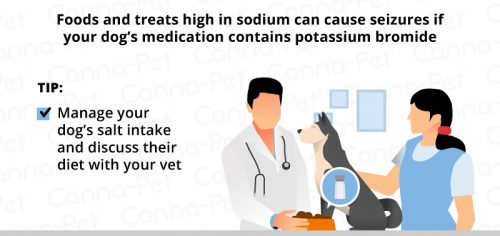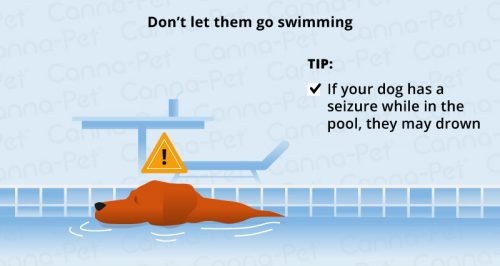Knowing Your Dog’s Epilepsy Triggers:
In some instances, you may notice that your dog has certain ‘triggers’ that can lead to his seizure. However, this may not be the case in all dogs, and triggers may vary between each animal. Many pet owners have noted that anxiety plays an influential part in their dog’s epileptic episodes, and have reported a variety of different situations, including a change in environment or routine, thunderstorms, car rides, and trips to the vet, among others. In addition, some pet parents have noted that their dogs seem hypersensitive to certain types of medications and food, which seem to trigger seizures. Keeping this information in mind, one of the most proactive things you can do is to keep a seizure diary of your dog’s episodes – by recording the details of each incident, you can help determine possible environmental triggers and provide your vet with helpful information that can help to formulate an effective course of treatment.
Treating Your Dog’s Epilepsy: Speak with Your Vet:
Although epilepsy is usually a lifelong and chronic condition, your vet can determine the best treatment options to ensure your dog’s quality of life. Certain factors such as type of seizure, how often your dog has a seizure, and if he has any problems with his kidney or liver will factor into the course of treatment your vet recommends. If your vet prescribes anti-seizure medication, be sure to discuss the administration protocols thoroughly. Furthermore, following up with your vet on a routine basis to monitor your dog’s condition and his reaction to the medication is essential. Because most cases of chronic epilepsy require lifelong treatment, periodic check-ups and blood tests will be required. Phenobarbital and Potassium Bromide are two medicines that are commonly prescribed for dog epilepsy. Phenobarbital is used for idiopathic epilepsy and Potassium Bromide is a secondary prescription that can be used if your dog doesn’t react well to Phenobarbital. In addition to medication, your dog’s vet may suggest changes in his diet. You may wish to discuss the benefits of dietary and nutritional supplements to further enhance his overall health and brain/organ function. It’s also important to maintain a consistent source of nutrition (i.e., not constantly switching dog foods, etc.), as changes to what he eats can alter his blood levels and how they respond to certain medications. Along with a change in diet, your vet may also recommend other natural alternatives to prescription medication for epileptic dogs. Recent advances in medicine include the development of a new dietary regimen for dogs, which may help to control your dog’s seizures.
Discuss pet food options with your vet, and always keep the following in mind if your dog requires medication for his epilepsy:
Be sure to administer medication at the same time each day
Always give them the correct dosage
Do not stop any dog seizure treatment without first consulting with your veterinarian
Keep a journal of your dog’s seizures and share results with your vet to track and monitor his progress, as well as help to identify ‘triggers’
Additional Tips for Dogs with Epilepsy:
If your dog is suffering from seizures or is epileptic, it is understandable that you want to do whatever you can to make him as comfortable as possible and avoid certain activities to prevent future episodes. Here are a few helpful tips to keep in mind for pet parents who are still familiarizing themselves with this common disorder:
Skip the salt: Studies have shown that foods and doggy treats high in sodium can actually cause seizures if they are on medications containing potassium bromide, so be sure to monitor your dog’s salt intake carefully and discuss a diet plan with your vet.
Avoid the pool: Because your dog may have an epileptic episode while swimming, he can be at risk of drowning. Therefore, you may wish to explore other safer ways to exercise and play.
Keep cool: During a long seizure, your dog is prone to overheating – one of the easiest ways to keep him cool is to put cold water on his paws and place a floor fan close by to help lower his body temperature until the episode is over.
Avoid the mouth & muzzle: Contrary to popular belief, your dog can’t ‘swallow’ his tongue – be sure to keep hands away from your dog’s mouth during a seizure, as he may be prone to snap or bite. It’s also imperative to keep his airway free of any and all obstructions.
Be mindful of episode length: If your dog has multiple seizures in a row (also known as ‘cluster seizures’) or one episode that lasts longer than 5 minutes, it’s important to bring him to your veterinary office immediately.
Reassuring your pet, removing any hazards from his environment (such as sharp-edged furniture), and even providing a pillow if he happens to be on a hard surface are all ways you can try to ease his discomfort if your dog is having a seizure.
Ultimately, as pet parents we want to treat epileptic seizures as compassionately as possible – depending on the underlying cause, your vet can help to treat your dog’s seizures to reduce their frequency and severity.



